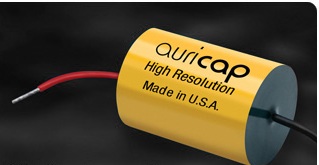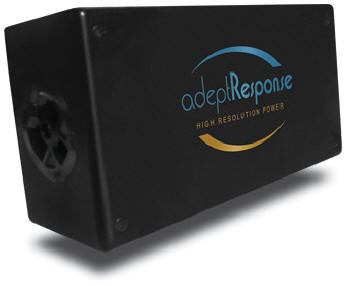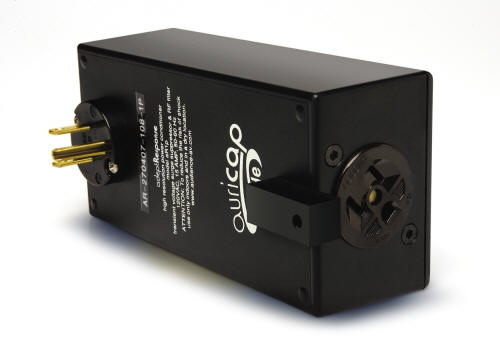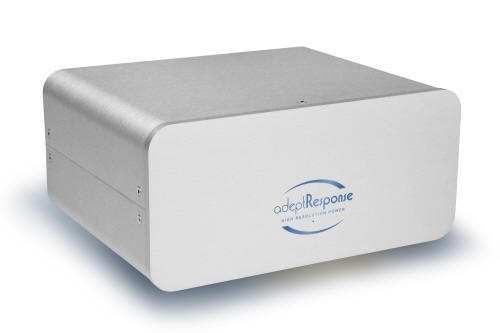You are reading the older HTML site
Positive Feedback ISSUE
march/april 2008
I need an audience: Adept Response
aR1p and the aR6 Line Conditioners from Audience
by Jeff Parks
This article took a little longer than my normal 90 days from receipt to actual article. Am I a procrastinator—maybe? Though this time being sick with that nasty flu that has been going around didn't help either. Try and listen to gear when your ear is down by 30dB due to an ear infection—not fun. Not that I avoid writing, it's that like most audiophiles I would rather listen to audio equipment than write about it. Don't get me wrong I do like to write about audio, or should I say talk about it—what audiophile doesn't? Writing is the chore, whereas, listening is the desert. So, for me grandmother's rule applies.
Why do I write about my experiences if writing is such a chore for me? I love to talk, or in this case share my expertise from what I have gathered being associated with the hobby for some 30 plus years. It is this sharing of ideas and experience that I hope keeps people interested in the hobby that is so near and dear to my heart. That is the reason why I still write about hi-fi and share my opinions about gear I find interesting and special. Today these special pieces of audio gear are from Audience - the Adept Response aR1 and aR6 line conditioners. These components (notice how I use the word component) are truly special as they actually do what they're supposed to—clean up the noise on the A/C line that can have a dramatic affect upon the overall sound of one's system.
Why the usage of the word "component" when referring to a line conditioner? The reason for calling a line conditioner a component is the fact that a line conditioner can have the same changing affect as switching out a piece of gear in your system—be it a preamplifier, turntable, cartridge, CD player, amplifier, cables, or speakers for that matter. All of these components are a summation of the whole of what one hears when listening to their rig. Just like any other component a line conditioner is just as important and effective at helping your system sound its best. For me, I believe it should be your first component to purchase when gathering a system together, since all things start at the source of power.
Many of us spend thousands of dollars for our high end systems to sound their best, and I am often surprised as to how many of these systems lack a line conditioner that is the same caliber as the rest of the gear in these systems. Or, worse, these systems do not have a line conditioner at all! For me, it makes no sense to do this, other than waiting to gather enough money to add a line conditioner as THE finishing touch for what is already an excellent sounding system. If designed properly, a line conditioner can make a big difference as to overall "end" sound of your system. Whether you choose to buy a line conditioner as your first or last component when creating that all special high resolution audio system, what is for sure, you really can't go without one if you are truly trying to hear your gear at its best.

My first association with Audience was with their great sounding Auricap capacitors way back in 2000. I modified a pair of Counterpoint NPS-100s stereo amplifiers converted into two 260 Watt per channel monoblocks through Mike Elliot at Alta Vista Audio using Audience Auricaps in key positions within the amplifiers amongst other parts in this upgrade. This was all a part of the "Premium" upgrade Mike was offering at the time. With such outstanding results I later upgraded my reference PS Audio Lambda II Special transport and PS Audio Ultralink II DAC using Auricaps in key positions as part of a complex rebuild of this digital gear. Although I really could not hear a significant difference with the upgrades and changes made to my transport, the DAC was another story. The first thing I noticed with the DAC was the outstanding bass response, followed with an ease about the music that I never heard before from digital during those days. I ended up keeping those two pieces in my system for 3 more years on top of my original 2 years prior translating to 5 years of ownership, which as you know for us audiophiles can be an eternity.
Later on I acquired a Counterpoint SA-5000 with the goal to take the plunge and dive in for full modifications. Why? Because, I really did like the result I got with my NPS-100s upgrades. Besides my friend Charlie had his SA-5000 fully upgraded through Mike and the results were outstanding. Never in my life had I heard such a liquid sounding preamplifier! Like so many of us audiophiles (we are a fickle group you know.), I changed my mind and focused elsewhere. Why the change of heart? I acquired a mint Audio Research SP-15 at a very reasonable price through one of my favorite local retailers—Brooks Berdan Ltd. in Monrovia, California. If you ever have a chance to stop by his shop you will be amazed at his commitment to all things high end audio—especially analog. Brooks is truly the high priest of high end analog music reproduction. For those who are unfamiliar with the Audio Research SP-15, it was the last of AR's SP offerings with what we would call today a full and complete preamplifier—meaning not only did it include a line stage but it also included a full fledged phono stage as well.
Many Audio Research fanatics stick their nose up at the SP-15 due to its hybrid design. Their complaints were that the preamp was too sterile and it lacked emotion. It didn't give them that tube "warmth" or euphonic sound so many tube lovers aspire to, whereas, for me, it was one of the few preamplifiers that stayed closest to the truth without getting in the way of the music. It was the neutrality, speed, and the sheer ability to truly respond to macro-micro dynamic demands with great precision and grace while at the same time staying true to the music is what attracted me to this once great preamplifier. Though I know there are many out there who may think I am nuts, in my humble opinion a dead stock SP-15 trounced the stock SA-5000. The SP-15 was more spatial, three dimensional, threw out a huge soundstage, and had better layering as compared to the SA-5000. So, I sold the SA-5000 as soon as possible and kept the SP-15.
I upgraded my SP-15 using Audience Auricaps, Black Gate caps, Cardas internal wiring, and Caddock Ultrafine resistors to name a few of the parts used in this full overhaul of this preamplifier. This newly upgraded SP-15 was a giant killer which I believe had a lot to do with use of the Audience Auricaps. Once again the same improvements were experienced similar to my PS Audio Ultralink DAC. The SP-15 had full bodied sound, deeper bass, larger soundstage, superior layering, and with what seemed as an extended and smoother high end response. In addition, that metallic tinge was gone—something that I believe was one of complaints of those who disliked the SP-15 in first place. Now this preamp was a keeper. To date, I regret I sold that preamp; it truly was one of my favorites.
Before we go any further with the article of the Audience aR-6 or aR1 I have to come clean with you all. I like, no, let me rephrase this; I love everything Audience produces, including their cables, I own Au24 cables for both speakers and gear, their powerChords, the Auricap series capacitors, and that killer Auric Illuminator. I know it may be hard to believe but painting and cleaning your CDs really does make a difference—the Auric Illuminator truly works. Maybe that is why I gave the Auric Illuminator a PFO Writer' Choice award way back on 2004. In addition, I am also a big fan of Audience's line conditioners as I personally owned an original series aR12 for powering up my home theater system over the course of the last three years.
Though the aR12 four years ago didn't light my wick with my 2 channel system (which I blame on a personal agenda I had at the time regarding that rig), it did wonders with my Pioneer Elite Plasma, Arcam FMJ AV-9 processor, FMJ P-7 amplifier, and DV-139 DVD player. My goodness! The colors on my plasma were amazing! They were richer and deeper in color, and with a more refined picture. The difference was so stunning it appeared like someone had just cleaned the glass on the screen. In addition, the aR12 clearly improved the overall sound of the system as well--blacks were blacker, highs were smoother, with a tinge of liquidity, and less metallic. This resulted in the midrange being fleshed out a bit without sounding forward or strident. And…, oh that bass it was taut with more dynamic power. Having the aR12 in my system seemed to have increased my power reserve by double. It was that dramatic! So, I wrote Audience a check and bought my review sample.
I have to equate all of these characteristics to the fact that the aR12 and those special Auricap capacitors used inside truly cleaned up the noise on the A/C line. It was this direct connection that was affecting the performance of my gear. In other words, if I am placing better gas or should I say electricity into the tank, it would seem obvious there would have to be some sort of improvement—wouldn't it? With this being said, it only makes sense that my gear is now running at its peak performance and maximizing its full potential. In my opinion the aR12 was a keeper.

Now we have the second generation of aR series line conditioners coming along with improved wiring, welding techniques along with some other goodies I will discuss in a moment.
About three months ago I was visiting my friends at Audience to re-terminate some powerChords, and as usual John and I got to talking. Like me, John is a talker. Ok, I may have him beat on that one, but each time we visit 10 minutes becomes 20 minutes which in turn becomes an hour or more. By the time I had finished talking with John I was leaving with my terminated cables along with a couple of aR1s along with a hint that maybe he would send me the new aR6—something I was very interested in reviewing for Positive Feedback. As soon as I entered the house I placed the aR1 on my wall and plugged in my Home Depot special A/C strip which was powering up my Sony Trinitron television that is well over 12 years old. Immediately I noticed a difference in the picture—the colors were more vivid and deeper. For me in this instance the aR1 was a keeper—problem solved. Mind you I didn't even let the aR1 break in; it was that good right out of the starting gate. One can only imagine as time rolls on the aR1 is only going to get better!

Next I placed the aR1 in my second system which consists of an Anthem Amp-2SE and Pre-2L SE, a Arcam CD-36T and a pair of Tannoy M-5s all cabled with Audience Au-24 cables. Yes, I know the cables maybe overkill for this modest system, however, each time I tried to place something else into the rig that was less expensive the system sounded dead, bright and constrained. So, back I went with the Au24s. To keep costs down I bought the best power strip I could afford, a Monster Cable unit. I can't remember the model number, but if it helps any the retail was around $89. Immediately, upon placement in the system the aR1 improved the sound. Once again the same improvements—blacks were blacker, which improved soundstage definition and imaging, a larger soundstage front to back and to the side of the speakers with a new sense of ease the system did not have prior to placing the aR1 into the rig. Once again, I opened up my wallet and gave John a check! This time though it was for both aR1s, the one powering up my bedroom television system, and the other powering up my second system.

Now on to the aR6—the focus for this article. As you all know the aR6 is the little brother to the top of the line aR12. Essentially the aR6 shares all of the same technology as the aR12. Think of the aR6 as half an aR12 and you are not too far from the truth. One nice feature of the aR line conditioners are their partial passive Power Factor Correction. To quote Roger Sheker (Audience's Chief Design Engineer), "this helps bring the voltage and current more into phase and makes the load look more like a resistor to the power line. As a result this process enhances the transfer of power making all Adept Response line conditioners more efficient and cleaner."
Though the aR6 can not fix the power fluctuations coming from the line into your home, it will make sure none of your gear interferes with anything plugged into the aR6 due to the fact that each outlet is separately filtered. Meaning once your gear is plugged into the aR6 power supply switching noise, or that pesky digital noise between outlets, is eliminated. In other words all outlets on the aR series of line conditioners operate as individual outlets. This is not like some line conditioners where one side of the conditioner is for analog and the other is used for digital due to the sharing of filtering.
Another feature, and in my opinion what makes a big difference in sound between the older Adept Response and today's Adept Response is, all wiring is hand welded to the buss bar using a proprietary high temperature technique that John is mum about. In the past, all connections were made by connecting the wires using spades and bolting them through a hole in the buss bar. Similar to the Adept Response units in the past Audience still uses the Auricap as its main filtering capacitor. This is the same cap, I reveled about in the beginning of the article. Like the older units as well the aR1, aR6, and aR12 all use the same cryogenically treated internal parts, chassis, and powerChord that is sold only through Audience.
Another unique feature of the Adept Response conditioners is, all include a six foot Audience powerChord terminated with the lock tight grip of the Neutrik PowerCon 20 amp connector. Why can't more manufacturers of high end audio gear use this type of connector? If they did we would have fewer cords slipping out of the back of our gear as the cords hang three feet or more above the floor connecting to either our line conditioners (I hope) or the A/C line itself. Again, like units of past the aR6 does not use switches, relays, or metal-oxide varistors all of which add noise and are current limiting. For turning the aR6 on and off that famed magnetic circuit breaker used in all aR12's is incorporated in the aR6 with the only difference is the switch is located on back of the aR6 as opposed to the front of the aR12. The designers choose this as switches they found were affecting the performance of the Adept Response line conditioners. Get this the results were even measurable! Even though the magnetic circuit breaker was several times more costly than the best switch Audience could find, the decision was made to use the magnetic circuit breaker—a decision Audience never regrets to date. All of these factors and design features truly define the perfectionism of what Audience is all about. Meaning this is a company that leaves nothing to chance—nothing more, nothing less.

Now on to the sixty-four thousand-dollar question, how does the aR6 sound? Now that is a hard question to answer. Why? Shouldn't a line conditioner if it is doing its job correctly sound like nothing? Meaning, all it is supposed to do is provide clean noise free A/C power. If that is the case, the sound should be the unadulterated sound of our gear source to speakers singing in perfect synergy working as one. To me, this is what is supposed to be happening--nothing more nothing less. Is this the case in my system now that the aR6 is in line cleaning up the grunge that pollutes my A/C line feeding my precious gear?
While I can't really say the aR6 has a sonic signature, I can say this: Since placing the aR6 in my rig, the system sounds clearer and more precise, almost like a veil or two has been removed from the musical presentation. This I equate to a blacker background with less noise as compared to the past. I am now hearing deeper, and with greater definition and detail into the music. Most importantly, that slight metallic sound I had in my system before placing the aR6 in my rig is now gone. Both micro and macro dynamics improved along with soundstaging which is now larger. Soundstaging has become more three dimensional on all planes of the musical stage. Images that sounded slightly opaque and recessed are now more pronounced and brought to the forefront and with greater clarity. Take for example my tried and true test track from Michael Ruff's album Speaking in Melodies—"Wishing Well." During the song Michael is accompanied by a small group of back-up singers. When this track is played using the best resolution available the four singers each occupy their own individual space on the soundstage. One of the most difficult singers to hear in this almost all male chorus is the lone female. When using only the A/C line as the source of power without the aR6 the chorus sounds congested and the woman's voice all but completely disappears. Place the aR6 back in line and voila!--the singers are back each occupying their own space on the soundstage. To me that is significant and right there well worth the price of admission! Once again the people at Audience did it again—the aR6 is a keeper!
As I have stated in other reviews I like to take my review samples on the road—especially when something lights my wick like the aR6 has done. In this situation I decided to bring the aR6 over to my friend John's home. John is a budding audiophile whom I set up a pretty nice starter system with a Anthem preamplifier and amplifier (Pre 1 and Amp-1), Arcam CD player (CD-36T), Tannoy speakers (M-3s), all using Audience Au24 cables. Notice I did say starter rig since like all of us who get bit by the audiophile bug it won't be long before John starts moving toward that upgrade path as his ears improve in hearing the details of the music coupled with that inner (neurotic) desire of trying to hear more from his music collection. This combination almost always is the hook that gets us audiophiles on the path toward audiophile nirvana where we change gear as often as our budget will allow it.
How did the aR6 sound in John's system? Again the same results: Blacks were blacker, soundstage was deeper wider. Highs were smoother with better detail and clarity without a hint of brightness or that metallic sound I hear so often in systems that do not use a line conditioner at all. Once again, the aR6 proved its worth. Furthermore, I tried this process with two other systems and again the results were the same. So, does that equate that the aR6 has a sonic character to it—maybe? One thing that is for sure in each and every system I placed the aR6 it made a difference in the sound of all of these systems for the better. Based up my experience I do believe that the Audience aR6 does bring us audiophiles one step closer to audio nirvana as it simply gets out of the way of the music, and allows our precious audio gear to perform its best. For me, the Audience aR6 is a keeper.
Postscript: At the end of this article I was just about to write a check to John at Audience for the aR6 when he told me to wait. Finding that unusual I inquired as to why. John stated he just got his hands on the new Teflon cap that Audience is now selling as the Aura-T capacitors. Though these caps will not be replacing the highly successful Auricap, the new Aura-T caps will represent another step in technology offered by Audience. The new Aura-T capacitors result in a new line of flagship Aura-T Adept Response conditioners offered in addition to the current Adept Response offering. Knowing me as John does, he stated I would not be satisfied until I hear the new top of the line Adept Response line conditioner—aR6-T (T for Teflon). If all things go according to plan soon after this article is published I should have in my hands this new aR6-T line conditioner. John is so sure I am going to love the aR6-T "that I better be prepared to write a check." That being said, it sounds like this story is not over just yet.
aR1p power conditioner
Retail: $495
aR6 power conditioner
Retail: $2800
Audience, LLC
web address: www.audience-av.com
